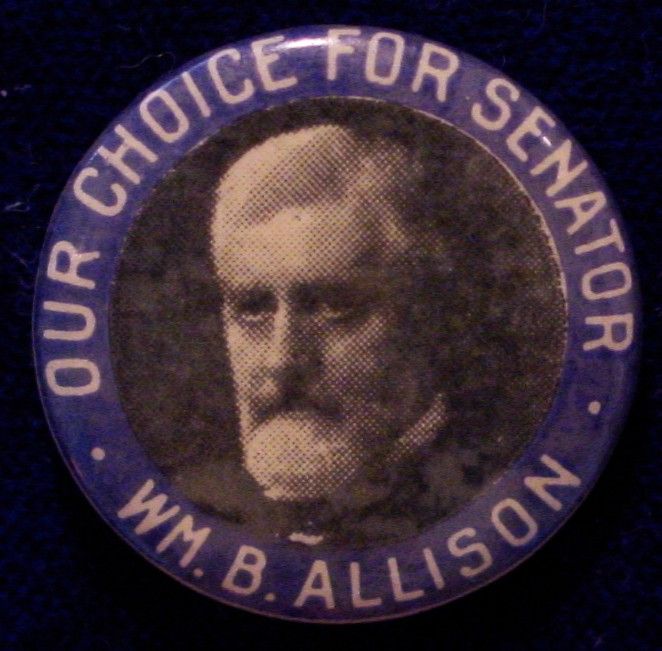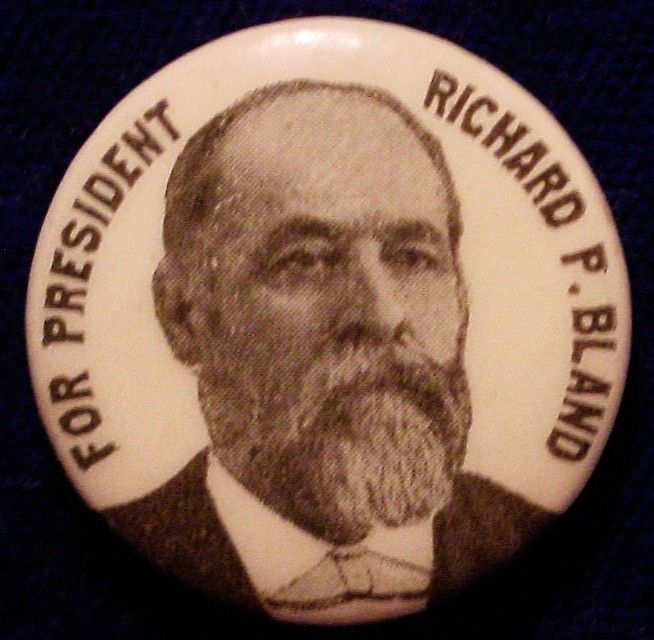The Men Who Sponsored the Morgan Dollar, Allison and Bland


It has taken me a couple of years, but at last I now have two political buttons that might interest some Morgan dollar collectors. Here are the buttons, one for Missouri congressman, Richard Bland and the other for Iowa senator, William Allison. Together they crafted a bi-partisan, the Bland - Allison Act which authorized the Morgan dollar.
The Coinage Act of 1873 authorized many changes to The United States coinage system. It ended the minting of the Two Cent Piece, Silver Three Cent Piece and the half dime, and slightly increased weight of the dime, quarter and half dollar to amounts that were more consistent with the Metric System. Of greater important at the time was the demonetarization of silver, the suspension coinage for the domestic silver dollar and the authorization of the Trade Dollar. The demonetarization of silver became the most onerous aspect of the bill for western mining interests and those who believed that massive increases in the money supply would cure all of the nation's economic ills. Its critics labeled it "The Crime of '73."
Prior to the enactment of the Coinage Act of 1873, depositors were able to bring gold and silver to the United States mint system and have it converted into coinage at little or no charge. The 1873 Coinage Act ended that practice for silver, but retained it for gold. The U.S. mint system would still produce silver coins for circulation but only in quantities that met the needs of the economy. The net result was that silver could no longer be converted into money easily, and the act put The United States on a de facto gold standard.
Congressman Richard Bland was strong advocate for the return of the "free coinage" of silver. In fact he was persistent advocate for the silver cause that he earned the nick name, "Silver Dick" Bland. He was able to get a bill that authorized the free coinage of silver through the House of Representatives, but it stalled in the Senate.
Senator William Allison was not an advocate of "free silver," but he did recognize that there was something worse. In the 1870s the Greenback Party arose as a political force. Their solution to the nation's ills was the unrestricted issuance of paper money or "greenbacks" which had been introduced during the Civil War. Although the Greenback Party candidates did not do well in presidential elections, they manage to elect 14 members to Congress and polled over a million votes for their congressional candidates. The political mussel of the Greenback movement prompted Senator Allison to craft a compromise bill with Congressman Bland.
The Bland-Allison Act of 1878 required the U.S. Government to purchase from two to four million dollars worth of silver per month and coin it into silver dollars. The bill put some limits on the amount of additional money that was introduced into circulation while it did add dollars to the money supply.
The net result for coin collectors was that the bill authorized the striking of millions of silver dollars that most people at the time did not want. These coins would sit in treasury vaults for a century in some cases and would reach collectors in later years in Brilliant Uncirculated condition.
The Bland-Allison Act became law during the first part of their political careers for both Bland and Allison. William Allison graduated from college, studied law and passed the bar in 1850. In addition to his law practice he served as a district attorney starting in 1856 and was a delegate to the Republican National Convention that nominated Abraham Lincoln for president in 1860. He served in Congress from 1863 to 1871 and declined to run for re-election in 1870. In 1872 the Iowa Legislature elected him the United States Senate. He would be re-elected to the Senate six times. At the time of his death in 1908 he had served 35 years and 5 months in the Senate, which was a record amount of time served in the Senate for the time.
Richard Bland was also a lawyer. In his youth he had moved to California and then Nevada. After being admitted to the bar, Bland practiced law in Virginia City, Nevada and took a strong interest in the mining industry. This may have accounted for his commitment to represent their interests in Congress. After Nevada became a state in 1864 he moved back to Missouri. In 1872 he won a seat in Congress and served there from 1873 to 1895 when he was defeated for re-election in 1894.
Ironically Bland was out of office when he was the front-runner for the presidential nomination at the 1896 Democratic National Convention. Bland did not have the nomination sew up with the two-thirds majority of the delegates that was needed at that time to be the party's standard bearer. After William Jennings Bryon rose to deliver his "Cross of Gold" speech, the delegates flocked to the young former congressman from Nebraska. The button shown above was one of the pieces that the Bland forces used during his brief bid as a presidential hopeful. Bland would win back his congressional seat in 1896 and serve in Congress until his death in 1899.
Retired dealer and avid collector of U.S. type coins, 19th century presidential campaign medalets and selected medals. In recent years I have been working on a set of British coins - at least one coin from each king or queen who issued pieces that are collectible. I am also collecting at least one coin for each Roman emperor from Julius Caesar to ... ?
1
Comments
Looking for Top Pop Mercury Dime Varieties & High Grade Mercury Dime Toners.
Member, Society of Silver Dollar Collectors.
Looking for PCGS AU58+ 1901-P, 1896-O, & 1894-O
I enjoyed the read very much
.
CoinsAreFun Toned Silver Eagle Proof Album
.
Gallery Mint Museum, Ron Landis& Joe Rust, The beginnings of the Golden Dollar
.
More CoinsAreFun Pictorials NGC FOR SALE
I think many should reread the passage that says "the bill authorized the striking of millions of silver dollars that most people at the time did not want." I always think about that whenever some member(s) rail about some of our Modern day issues, realizing that history does in fact repeat itself.
thanks again, Bill.
Experience the World through Numismatics...it's more than you can imagine.
I love these posts, Bill. I wish they stimulated more discussion.
"Look up, old boy, and see what you get." -William Bonney.
Jim
Great post Bill